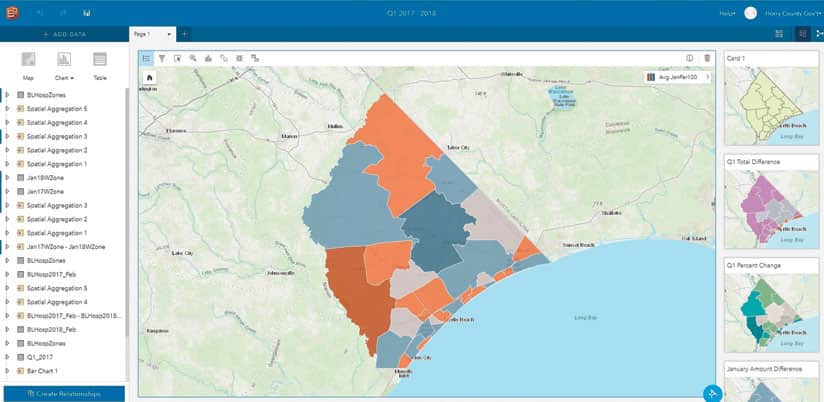Coastal County Uses Insights for ArcGIS to Analyze Trends and Make Predictions
Horry County, South Carolina, is home to more than 300,000 full-time residents, and its beach towns host several million visitors each year. In 2016 alone, the county’s most famous seaside sanctuary, Myrtle Beach, saw a whopping 18.6 million visitors, according to tourism research company D.K. Shifflet & Associates.
Not surprisingly, the area’s economy is heavily dependent on tourism. That is in part why all businesses operating within county limits must collect a 1.5-percent hospitality tax on food, beverages, accommodations, and entertainment. That tax money is then used to fund tourism initiatives, such as beach patrol and cleanup, and Chamber of Commerce activities.
While gross revenue from tourism was generally trending upward, Horry County wanted to get a more granular look at the overall health of this economic sector so it could allocate the hospitality budget more fittingly and better support tourism. County staff needed a way to analyze business revenue data alongside weather, crime, development, and other factors that could contribute to increasing or declining tourism. They wanted to be able to understand patterns and make predictions about whether a tourist-based business would succeed or fail.
To do this, the county needed to be able to examine the data based on specific locations so it could scrutinize various submarkets more closely. Horry County’s IT team decided that Insights for ArcGIS would work best for doing this kind of analysis.
Analyzing Data in Aggregate and at the Submarket Level
Once Insights for ArcGIS was implemented, Horry County’s administration, finance, and business license departments were able to use this web-based workbench to explore both spatial and nonspatial data in an array of maps and charts. Now, they can understand fluctuations in revenue as an aggregate, as well as at the submarket level. They can also identify trends and predict outcomes for local businesses and government agencies, all with an eye toward serving both tourists and citizens.

For example, if a golf course reports low profits for the year, is that indicative of a larger trend for all golf courses in the area, or is it an isolated issue? With Insights for ArcGIS, Horry County staff can do a rigorous investigation of this question with just a few clicks.
If other golf courses also report low profits for the year, staff at the county can analyze that data alongside information about the weather and natural disasters to try to pinpoint the root cause. If other golf courses report higher profits, the county can cross-reference that with building permit records, for instance, to see if the low-earning golf course was under construction at any point during the year.
“The minute you open [Insights for ArcGIS] and look at the charts…you know exactly what’s happening in specific submarkets and why areas have declined [while] others are hitting the high notes,” said Tim Oliver, Horry County’s chief information officer. “In the past, this analysis would have taken days.”
Exploring Ways to Boost Tourism Revenue
Prior to implementing Insights for ArcGIS, Horry County staff had to comb through reports on thousands of businesses to do comparison analyses.
“The only thing available previously might have been a ZIP code sort in Excel, which would not even begin to provide the level of detail and analysis that is being done in Insights,” said Oliver.
Now, users can divide the whole county into submarkets to show the tourism-based economies situated around well-known venues, such as Myrtle Beach’s Broadway at the Beach entertainment complex; various businesses along the stretch of coastline called The Strand; and local universities and colleges, like Coastal Carolina University. They can then quickly understand if one of these submarkets is up or down based on the previous year and identify which businesses or circumstances are causing the change. Did one submarket see a drastic increase in revenue because a new entertainment venue went in that wasn’t there six months ago? Did another have a substandard year because more restaurants opened up in an adjacent neighborhood?
Users can also bring in data on crime rates and weather to dive deeper into what’s causing each trend. Additionally, they can use demographic data from Esri to delve into psychographic and socioeconomic information for each submarket
The minute you open [Insights for ArcGIS] and look at the charts…you know exactly what’s happening in specific submarkets and why areas have declined [while] others are hitting the high notes. In the past, this analysis would have taken days.
Depending on the results, Horry County can then explore concrete actions to take to ensure that submarket revenues either stay steady or improve.
“If Insights determines that criminal activity in a submarket negatively affects revenues, will an increase in policing be able to provide a safer experience, or will it also change the demographics of the visitors to that area?” posited Oliver. “Those are things we now have the ability to analyze over time.”
Scaling Analysis to the Required Geographic Level
With Insights for ArcGIS, Horry County can perform speedy, accurate, and repeatable analyses on how well local businesses are doing—and all this scales to the geographic level required. Once one type of analysis is performed, the app stores the model so other users can easily rerun it with fresh or different data.
Horry County can also share this information with the Chamber of Commerce, an economic development consortium, and state-level agencies so they, too, can see where additional support is needed to help keep local businesses solvent.
“The local economy is driven and supported by tourism,” said Oliver. “It’s not just the hospitality tax that benefits the county. Sales tax, jobs, and subsequent housing and development are all impacted by tourism.”
While the hospitality tax was the impetus for getting Horry County to analyze this data on submarket levels, Insights for ArcGIS is fast becoming the trusted source for gaining a better understanding of the overall health of Horry’s tourism economy. That’s because it’s simple to use and breaks down complex issues into manageable nuggets.

